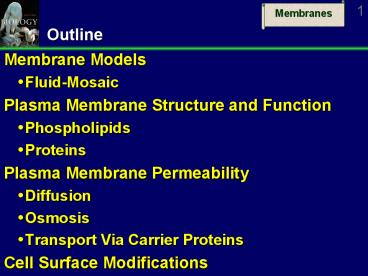Outline Membrane Models Fluid-Mosaic Plasma Membrane - PowerPoint PPT Presentation
1 / 41
Title:
Outline Membrane Models Fluid-Mosaic Plasma Membrane
Description:
Outline Membrane Models Fluid-Mosaic Plasma Membrane Structure and Function Phospholipids Proteins Plasma Membrane Permeability Diffusion Osmosis Transport Via ... – PowerPoint PPT presentation
Number of Views:196
Avg rating:3.0/5.0
Title: Outline Membrane Models Fluid-Mosaic Plasma Membrane
1
Outline
- Membrane Models
- Fluid-Mosaic
- Plasma Membrane Structure and Function
- Phospholipids
- Proteins
- Plasma Membrane Permeability
- Diffusion
- Osmosis
- Transport Via Carrier Proteins
- Cell Surface Modifications
2
Structure and FunctionThe Phospholipid Bilayer
- The plasma membrane is common to all cells
- Separates
- Internal living cytoplasm from
- External environment of cell
- Phospholipid bilayer
- External surface lined with hydrophilic polar
heads - Cytoplasmic surface lined with hydrophilic polar
heads - Nonpolar, hydrophobic, fatty-acid tails
sandwiched in between
3
PlasmaMembrane
4
Unit Membrane
5
Membrane Models
- Fluid-Mosaic Model
- Three components
- Basic membrane referred to as phospholipid
bilayer - Protein molecules
- Float around like icebergs on a sea
- Membrane proteins may be peripheral or integral
- Peripheral proteins are found on the inner
membrane surface - Integral proteins are partially or wholly
embedded (transmembrane) in the membrane - Some have carbohydrate chains attached
- Cholesterol
6
Fluid Mosaic Model
7
The Fluid Mosaic Model
8
(No Transcript)
9
Phospholipid CholesterolMolecules
10
Transmembrane Proteins
11
Functions of Membrane Proteins
- Channel Proteins
- Tubular
- Allow passage of molecules through membrane
- Carrier Proteins
- Combine with substance to be transported
- Assist passage of molecules through membrane
- Cell Recognition Proteins
- Provides unique chemical ID for cells
- Help body recognize foreign substances
- Receptor Proteins
- Binds with messenger molecule
- Causes cell to respond to message
- Enzymatic Proteins
- Carry out metabolic reactions directly
12
Membrane Protein Diversity
13
Types of TransportActive vs. Passive
- Plasma membrane is differentially (selectively)
permeable - Allows some material to pass
- Inhibits passage of other materials
- Passive Transport
- No ATP requirement
- Molecules follow concentration gradient
- Active Transport
- Requires carrier protein
- Requires energy in form of ATP
14
(No Transcript)
15
(No Transcript)
16
Types of Membrane TransportOverview
17
Types of TransportDiffusion
- A solution consists of
- A solvent (liquid) , and
- A solute (dissolved solid)
- Diffusion
- Net movement of solute molecules down a
concentration gradient - Molecules both ways along gradient
- More move from high to low concentration than
vice versa - Equilibrium
- When NET change stops
- Solute concentration uniform no gradient
18
Types of Membrane TransportDiffusion
19
Types of Membrane TransportDiffusion Across Lung
20
Types of TransportOsmosis
- Osmosis
- Special case of diffusion
- Focuses on solvent (water) movement rather than
solute - Diffusion of water across a differentially
(selectively) permeable membrane - Solute concentration on one side high, but water
concentration low - Solute concentration on other side low, but
water concentration high - Water diffuses both ways across membrane but
solute cant - Net movement of water is toward low water (high
solute) concentration - Osmotic pressure is the pressure that develops
due to osmosis
21
Types of Membrane TransportOsmosis
22
Types of TransportOsmosis
- Isotonic Solution
- Solute and water concentrations equal on both
sides of membrane - Hypotonic Solution
- Concentration of solute lower than on other side
- Cells placed in a hypotonic solution will swell
- May cause cells to break Lysis
- Hypertonic Solution
- Concentration of solute higher than on other side
- Cells placed in a hypertonic solution will shrink
- Plasmolysis
23
Osmotic Effects on Cells
24
Types of TransportCarrier Proteins
- Facilitated Transport (no energy expenditure)
- Small molecules
- Cant get through membrane lipids
- Combine with carrier proteins
- Follow concentration gradient
- Active Transport
- Small molecules
- Move against concentration gradient
- Combining with carrier proteins
- Requires energy, such as the use of ATP
25
Passive vs Active Transport
26
Types of Membrane TransportFacilitated Transport
27
Facilitated TransportThe Sodium-Potassium Pump
28
Sodium-Potassium Pump
29
Types of TransportMembrane-Assisted Transport
- Macromolecules transported into or out of the
cell inside vesicles - Exocytosis Vesicles fuse with plasma membrane
and secrete contents - Endocytosis Cells engulf substances into pouch
which becomes a vesicle - Phagocytosis Large, solid material into vesicle
- Pinocytosis Liquid or small, solid particles go
into vesicle non-specific - Receptor-Mediated Specific form of pinocytosis
using clathrin (coated pit)
30
Membrane-Assisted TransportThree Types of
Endocytosis
31
Membrane-Assisted TransportExocytosis
32
Receptor Mediated Endocytosis
33
(No Transcript)
34
CoatedPitsandVesicles
35
Cell Surface ModificationsJunctions
- Despite their thickness, cells do not totally
isolate themselves from one another. - To function in a coordinated way as part of a
tissue, the cells must have cell junctions, which
are structures that connect them to one another.
36
Cell Surface ModificationsJunctions
- Cell Surfaces in Animals
- Junctions Between Cells
- Adhesion Junctions or anchoring junctions
- Intercellular filaments between cells attach
adjacent cells to each other - Tight Junctions
- Form impermeable barriers b/w cells leak-proof
- Gap Junctions aka communicating junctions
- Plasma membrane channels are joined (allows
communication) allow molecules to flow b/w cells
37
Cell-Surface ModificationsJunctions
38
Cell Surface Modifications
- Extracellular Matrix
- External meshwork of polysaccharides and proteins
(sticky layer of glycoproteins) - Found in close association with the cell that
produced them - Plant Cell Walls
- Plants have freely permeable cell wall, with
cellulose as the main component - Plasmodesmata penetrate cell wall
- Each contains a strand of cytoplasm
- Allow passage of material between cells
39
Cell-Surface ModificationsExtracellular Matrix
40
Cell-Surface ModificationsPlasmodesmata
Channels between adjacent plant cells that form a
circulatory and communication system connecting
the cells in plant tissues.
41
Review
- Membrane Models
- Fluid-Mosaic
- Plasma Membrane Structure and Function
- Protein Functions
- Plasma Membrane Permeability
- Diffusion
- Osmosis
- Transport Via Carrier Proteins
- Cell Surface Modifications

